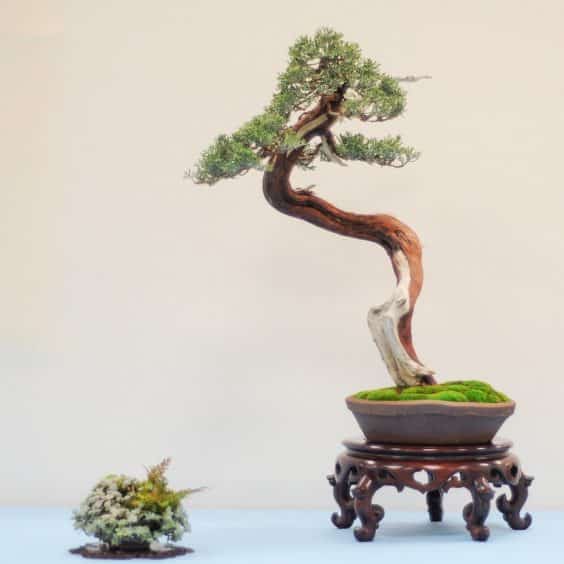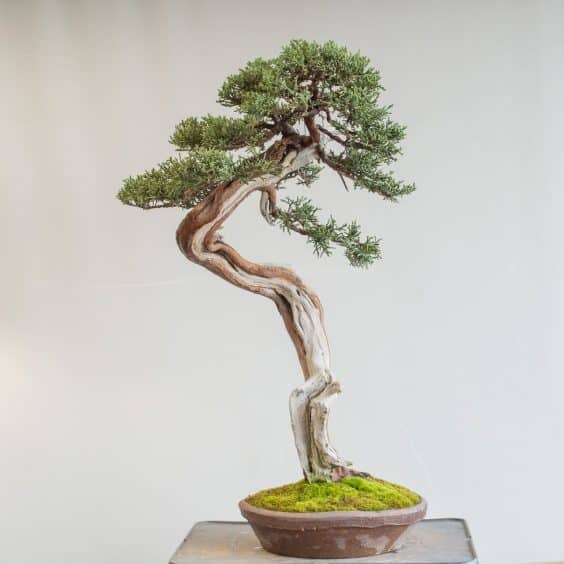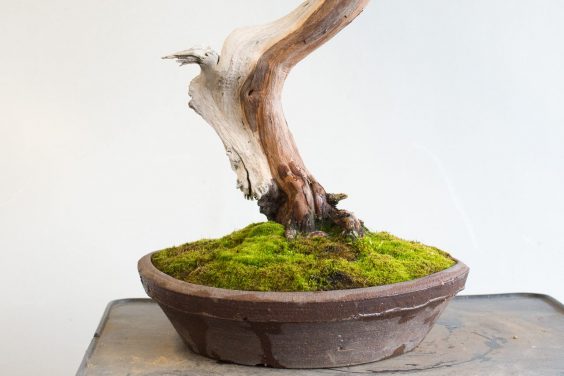One of the challenges I faced with the Western juniper below was that it had no roots on one side of the trunk. This was natural as the tree got its start when it was separated from its larger sibling. Here it is after a few years of training.
Western juniper, 2009 – note how the base of the trunk hugs the side of the pot
Although the pot was a good match for the tree, it looked silly to have it planted so far to one side. One alternative would have been to use a larger pot, but that may have also looked silly.
Once more roots developed closer to the base of the trunk, I could remove some of the roots that emerged further out. This let me move the trunk closer, but not quite to the middle of the pot.
As displayed at Bay Island Bonsai’s 2010 exhibit
Over the next few years I didn’t think as much about where the trunk emerged from the pot. It was only natural that I tried to center it each time I repotted as trees with slender trunks are typically centered when planted in round pots.
And then just a few days ago, I paused while watering the tree and remembered back to when it was planted way off to one side of the pot. It took a long time to get here, but I now have great flexibility when it comes time to refine the front and potting angle as there is a solid rootball centered around the trunk.
2017 – Centered at last
As seen from the right side
Of course, the rest of the tree still needs a lot of work, but that’s part of the fun too.
Subscribe to Bonsai Tonight
New Posts Delivered Every Tuesday and Friday




Brian says
Wow what an incredible progression. It’s amazing to see the evolution of both the trees development and its interaction to a pot simultaneously. How long was the tree hugging the pot, before it developed enough roots to be centered? Or how long was the plant in the “2009” state?
Jonas Dupuich says
Thanks Brian. Am not sure exactly how long the tree was in the 2009 state, but I’d guess 1-2 years. Before that, it was in a terra cotta pot for 2-3 years.
Mac McAtee says
I have several trees in the same progress. A Live Oak, Princess Persimmon and an azalea. When repotting it’s sometimes tempting to just go ahead and make a big cut and move the tree where it needs to be. When I start getting that urge when repotting I walk a way for a few minutes and look at some other trees, go back and continue to just remove a small amount of offending root and take satisfaction that it’ll get there one day.
I have read so many articles about Princess Persimmon not liking their roots tampered with I reall take small bites of the apple with it.
Thanks for the post and the progression photos. It gives me more confidence that I am doing right by my trees.
Danny says
The design has come a long way since 2010 as well. I particularly like how the pads on the left side are well defined and aren’t a solid slope now.